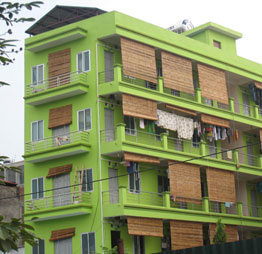Since mini-apartments were legalised in Hanoi, the market quickly developed throughout the city.
 |
| A mini-apartment block on Nguyen Khanh Toan Street, Hanoi |
Phan Thanh Giang was on the lookout for a new place. On the recommendation of a friend he looked into a 5-storey building in Phu Do Village near My Dinh National Stadium. The owner of the building was waiting for him at the gate.
Tran Thi Canh, the building’s owner, led Giang to see two apartments on the third floor. They were both 40-square metres and housed a living-room, a bedroom, a toilet and a kitchen. “This building has 15 apartments, all of them have a similar area and design,” Canh told her guest. “We’ve sold the other apartments, except for these two on this floor. We are asking for VND 900 million.”
Seeing his guest’s hesitation, the middle-aged landlord offered to show another building on Nguyen Khanh Toan Street. “Apartments in this area are a little bit more expensive,” she warned, adding that the block was newly-built. “You should make a quick decision and pay a deposit because demand for these mini-apartments is really high.”
And that statement was no sly selling ploy. Since mini-apartments won legal recognition, more people are hunting them down and the prices of these apartments are skyrocketing.
According to Truong Nam Anh, director of Nam Anh Real Estate Agency in Hanoi, after a new government decree was introduced in August allowing locals to build and sell apartments of 30-square-metres and up, the market has been booming.
“Though prices have been soaring, we are still short of supply,” Anh said. “A 30 square metre apartment in Cau Giay District, which was priced at around VND600-700 million last year, is now selling for over VND1 billion.”
Mini-apartments are usually found in crowded residential areas home to large numbers migrants such as Cau Giay and Thanh Xuan Districts. They range in size from 30 to 40 square metres.
Pham Van Huy brought a 110 square metre block of land near his house to build apartments on.
“Since mini-apartments were allowed legal status, the market started to develop. I believe that mini-apartments will attract clients thanks to their low prices,” Khuong said.
Meanwhile, Deputy Minister of Construction Nguyen Tran Nam said that he was clueless to the idea of small apartments.
“However, in reality, the mini-apartments do exist and now people are rushing to purchase them,” he said. “Mini apartments have helped solve the high demand for housing, and there is no reason to ban them.”
That could be bad news for clients such as Phan Thanh Giang who are finding it tough to find one. “I’ve been trying to a place for over a month but with little luck,” Giang said. “They are becoming scarce. I must be quicker in making a decision.”

Leave your comment on this story